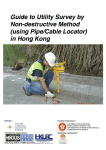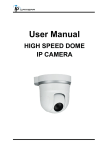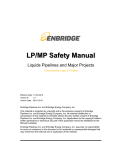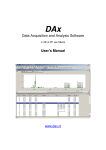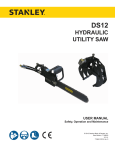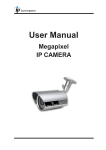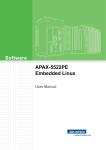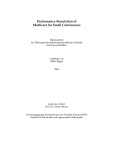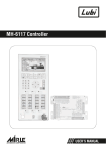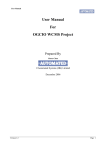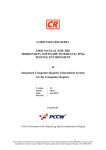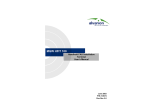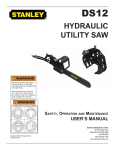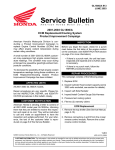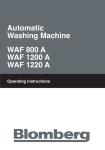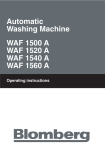Download - Hong Kong Institute of Utility Specialists
Transcript
Acknowledgements The authors would like to acknowledge the financial fund under Professional Service Development Assistance Scheme (PSDAS) of Commerce and Economic Development Bureau, The Government of the Hong Kong Special Administration Region as well as technical support of Hong Kong Institute of Utility Specialists (香港管綫專業學會)and Hong Kong Utility Research Centre (香港 管線管理研究中心)as well as their company members. Additionally, the support of relavant government departments should be acknowledged for their contribution to the information related to operation, standards, and contract requirements. List of Company Members of HKIUS (according to alphabet): (1) APC Surveying & Building Limited (2) BUDA Surveying Limited (3) B.P. (Building & Engineering) Co., Ltd (4) EGS (Asia) Limited (5) Freyssinet Hong Kong Ltd. (6) INNO Pipe Engineering Limited (7) Insituform Asia Limited (8) Jetrod Pipeline Consultant and Engineering Ltd (9) Patrick Yuen Underground Detection Company Limited (10) Stanger Asia Limited (11) Toptime Technologies Ltd. (12) US & Associates Consulting Co.,Ltd (13) UtilityINFO Limited (14) U-Tech Engineering Company Ltd. Editor in Chief Ir Dr. King Wong Editor L.M. Cheung, C.C. Chui, C.W. Hui, W.Y. So Consultant Ir Spencer Li This guideline is done in May 2011. Page2 FOREWORD After the disastrous landslip of 1994 occurred in Kwun Lung Lau on Hong Kong Island, the Government has paid more attention on utility maintenance with particular emphasis on leakage detection of buried water carrying services on both slopes and roads. The Government has increased resources and imposed additional legislation on the detection of underground utilities. As a direct result, the utility profession has been developing rapidly, and over the last decade, the number of “Utility Specialists” ( 管 綫 專 業 監 理 師 ) has grown as the Government‟s requirements for Competent Persons to carry out the investigations has been implemented, in addition, Recognized Professional Utility Specialist (RPUS) (管綫專業監察師) has been recognized in recent years. However, lack of standard surveying methods, centralized monitoring systems and organized management, have lead to unsatisfactory investigation results. In order to address these issues, Hong Kong Institute of Utility Specialists (HKIUS) (香港管綫專 業學會), targeting the promotion of knowledge and good practice in the utility profession, collaborated with Hong Kong Utility Research Centre (HKURC) and supported by the funding from the Professional Services Development Assistance Scheme (PSDAS) of HKSAR, published a series of guide books and pamphlets in 12 disciplines of the utility profession in order to set standards for the practitioners to follow. As part of HKIUS continual effort to enhance the professionalism of the utility profession, it is the intention of the series that the quality of the survey can be raised and that utility related incidents can be avoided by performing high quality utility practices. Hopefully, the resulting benefits can extend to the general public. This issue provides good practice of Utility Data Management (DM) (管綫資料管理). It states the ways to manage the data of underground utilities so that the system can be properly maintained. This document is intended to be used by all personnel involved in the works. _________________________ Mr, Zico Kai Yip KWOK (郭啟業先生) President, HKIUS (2010-11) April, 2011 Page3 Table of Content FOREWORD ....................................................................................................................................... 3 Table of Content................................................................................................................................... 4 1. INTRODUCTION ........................................................................................................................... 5 2. OBJECTIVE AND SCOPE ............................................................................................................. 6 3. TYPES OF UTILITY DATA .......................................................................................................... 7 4. STAGES OF DATA MANAGEMENT .......................................................................................... 9 4.1 Keeping of data after new installment ........................................................................................... 9 4.2 Update of data after survey ............................................................................................................ 9 4.3 Centralized data for future use ..................................................................................................... 15 5. DATA MANAGEMENT TOOL ................................................................................................... 16 5.1 Data processing ............................................................................................................................ 17 6. UPDATED TECHNOLOGIES ON UTILITY DATA MANAGEMENT .................................... 23 6.1 Geographical Information System (GIS) ..................................................................................... 23 6.2 Electronic Marker System (EMS) ................................................................................................ 23 REFERENCES................................................................................................................................... 29 Appendix A: Abbreviations ............................................................................................................... 30 Page4 1. INTRODUCTION The underground utility systems in Hong Kong are rather complex but extremely important in supporting the growth of our society. Construction, maintenance and repair can be extremely difficult. As every utility system is laid according to their own requirement and there is no general system governs all the individual system and how they shall be laid under a systematical manner, the system is unorganized. It is uneasy to predict the alignment of the services. Therefore, the records of the utilities become an important indication regarding the alignment of the utilities. An organized database of the utility system gives convenience to future maintenance, upgrade, and installation of new utilities within the system. Utility system came from various utility undertakers, public or private. Each of them has their own database and system. General type of underground utility systems in Hong Kong include drainage service, fresh and salt water supply, electricity power, gas, communication, street lighting and government signaling system. The utility undertakers keep their records separately. This hinders the efficiency of utility works. As the city develops, the demand for utility services is also growing. The number of utility services buried underground is enormous. Without comprehensive and accurate record of the location of the utilities, there is a higher possibility of damage to utility or accidents caused by excavation works. Therefore, utility data management is necessary and shall be part of the responsibilities of all utility practitioners. A well-managed utility system can reduce the cost of maintenance and risk of utility related accidents. HKIUS with support from Utility Training Institute (UTI) and Hong Kong Utility Research Centre (HKURC), aiming at maintaining a healthy underground drainage system and safe working environment, prepared guidelines to provide a standardized process of utility data management in order to promote a good practice for the practitioners. Page5 2. OBJECTIVE AND SCOPE Utility data refers to the structural details of the services such as function of the services, location, diameter, material, length, etc. of the services. The purpose of this guide is to provide recommendations on good practice of the methods of utility data management to enhance the efficiency of the utility data system. A well-managed database provides comprehensive information regarding the services including their locations, features and conditions. Since a large amount of data in different kinds is being processed, powerful tools and system shall be employed or established to process the data. This document provides standardized processes and recommends the use of systematized information recording systems to minimize errors. It aims at providing guidelines for the practitioners to follow and to improve the organization of the data. This guide provides information on the data that shall be processed and tools for processing. It must be stressed that the guidelines given in this guide are in no way exhaustive, and professional judgment must be employed in all cases. This guide is intended to be used by all personnel who are involved in the planning, commencement and supervision of manhole internal condition survey, including contractors, utility companies, consultants, government departments and other parties concerned. Page6 3. TYPES OF UTILITY DATA There are different kinds of utility services serving the community. Before the information can be well-managed, knowing what information shall be collected and stored is important. Information that shall be stored is listed below. Surface water drainage All drains and drain connections with invert levels All manholes which are within survey area and immediate upstream and downstream manholes outside the survey area Type and diameter of pipe work Connections to storm/foul and combined water sewers Depth below ground shall be annotated at each surface feature and at significant changes of depth Internal dimensions of manholes and invert levels of manholes and their connection pipes Foul sewerage All sewers and sewer connections with invert levels All manholes within the survey area and also immediate upstream or downstream manholes outside the survey area Type and diameter of pipe work Connections to foul/storm and combined water sewers Depth below ground shall be annotated at each surface feature and at significant changes of depth Internal dimensions of manholes and invert levels of manholes and their connection pipes Water mains (including cooling water mains) Pipe routes including fire mains with levels Valves and meter pits Diameters and material specifications (from record) Classifications (i.e. salt water, fresh water, cooling water, etc) Owner/operator Connections to building Depth below ground shall be annotated at each surface feature and at significant changes of depth Dimensions and levels of the thrust blocks & concrete surrounds (if available from record or by extensive GPR survey by instruction after PCL survey) Internal dimensions of the inspecting valve and meter pits Telecommunications Cable routes with levels, numbers and sizes of ducts Cable draw pits and manholes Owner/operator Connections to buildings Depth below ground shall be annotated at each surface feature and at significant changes of depth Number and configuration of cables/ducts Dimensions and levels of concrete surrounds (if available) Internal dimensions of the inspecting cable draw pits and manholes Page7 Ventilation ducts Grilles and underground ventilation ducts including duct routes, levels and sizes Depth below ground shall be annotated at each surface feature and at significant change of depth Electricity Cable routes and levels Cable draw pits and manholes including those associated with traffic control and street lighting Voltages classified as: Low (0-11kv), High (below 11kv-66kv) and Transmission (132kv or over) Connections to buildings Depth below ground shall be annotated at each surface feature and at significant changes of depth Dimensions and levels of concrete surrounds (if available) Internal dimensions of the inspecting cable draw pits and manholes Cable TV Cable routes with levels and junction boxes Connections to buildings Depth below ground shall be annotated at each surface feature and at significant changes of depth Dimensions and levels of the inspecting concrete surrounds (if available) Internal dimensions of cable draw pits and junction boxes Combined services ducts Internal box dimensions of ducts and access points All pipes and cables identified and surveyed as for individual services Dimensions and levels of the inspecting concrete surrounds (if available) Gas main Pipe routes with levels Valve and meter pits Diameters, material specifications and working pressures Depth below ground shall be annotated at each surfaced feature and at significant changes of depth Dimensions and levels of concrete surrounds (if available) Internal dimensions of the inspecting valve and meter pits Other services Other services including abandoned services which are located during the survey shall be recorded with any available information regarding the identity or type of materials or services Page8 4. STAGES OF DATA MANAGEMENT 4.1 Keeping of data after new installment When new utilities were laid underground, records shall be kept by the utility owners. The utility owners shall be able to provide the record plan of the new utilities. Detailed structural information of the service shall be recorded. Besides structural information of the utilities, other information such as when the pipe was laid, any special circumstances of the surroundings, is useful reference for future maintenance works. 4.2 Update of data after survey Investigation and maintenance works may carry out periodically to ensure the services are functioning properly. Records of such works shall be kept by the owner as well as the agent who carries out the works. Any change to the pipe shall be recorded and correspondent update shall be made to the original record. If it is found that the information of the record plan does not match the actual situation during investigation, the service perhaps had been moved without notice to the utility owner. The actual situation shall be recorded and informed to the respective Utility Undertakers (UU). The respective UU shall survey the utility cable/duct/pipe on site, update the record drawings in question and remove abandoned utility services on site if necessary. The purpose of different survey is different and so it provides different information. The result of the survey conducted shall be firstly reported and then entered to a database for records. To ensure the accuracy, the data shall be checked and verified to avoid conflicts or inconsistency among the data before the release of final result. Manhole internal condition survey The purpose of manhole survey is to investigate the condition of manhole. Details and defects (if any) of manhole will be recorded on a manhole card on site. Information recorded shall include the location, structural features, connections and sketch of the manhole. Page9 Fig. 4.2.1. Window for entering information collected by Manhole Internal Condition Survey. Computer programmes create overlay drawings. They can plot manholes and their connecting pipes on the map according to the information entered. Details like manhole reference, pipe diameter and function of the pipe are also shown in the plan for easy reference. For data storage, each batch of manhole records submitted shall be assigned a unique survey filename. Each computer programme may store the data in different format. The data stored shall be able to be retrieved and searched later on despite the format. For quality control, computer software can check the consistency and accuracy of the data. This option is used to check the consistency of node data and to produce relevant inconsistency reports. Any duplication or intersection can also be checked. Page10 Reporting - Result of the manhole internal condition survey shall include all necessary information including: 1) Location plan with all the manholes plotted within the survey extent. 2) IDMS manhole record card. 3) At least 2 photographs (location photo and internal photo). 4) Condition photos for any other circumstances. 5) Corresponding electronic data by computer programme validated by RPUS. CCTV survey The purpose of CCTV survey is to investigate any structural or operational defect in the conduit. The CCTV video and coding of defects are essential for analysis. Coding of defects shall be done on-site and to be processed by computer programme either on site or in office. Mandatory information shall be entered. Each defect code shall be accompanied a photograph captured from the video. In order to evaluate the condition of the conduit, grading and scoring system are applied. Computer programme shall be employed to calculate the scores and final grade of the conduit. The whole video record shall also be kept. The programme can also check for any contradicting information. For example, the consistency of the starting and fininshing manholes. Reporting - Result of CCTV Survey shall include all necessary information including: 1) Operator‟s report – background information, summary of pipes, summary of defects, recommendations by OMHKIUS 2) Layout plan 3) Video record – video record of the entire inspection 4) Survey result by MHKIUS 5) Photographs – general photographs at 5m interval (if no defect is found) defect photographs capturing defects and defects shall be clearly seen 6) Final grading of internal condition by RPUS. Page11 Fig. 4.2.2 Window for entering CCTV Survey result. Utility Survey The purpose of utility survey is to investigate the location, alignment and depth of the utility services. The exact location of the underground services (such as cables, pipes, mains) as well as surface installations (such as manholes, fire hydrants) shall be recorded. Information of each facility shall be entered. Computer programme can be employed to create the utility plan. Computer programmes are capable of creating the plan automatically using the information entered. Fig. 4.2.3 Drawing shall be created after survey. Page12 Fig. 4.2.4 Plans shall be created after survey. Reporting - Result of utility survey using pipe/cable locator shall include all necessary information including: Survey report – name and certificate number of competent person, mandatory information, survey result, recommendation by OMHKIUS. Site photographs. Information of equipments used. Utility survey drawing - alignment, depth, diameter, direction (drainage services), type of the services, location of manholes and other related surface installations by MHKIUS. Report to be confirmed by RPUS. Water leakage detection survey The purpose of water leakage detection is to investigate the structural integrity of the water mains. Any leakage of the pipe shall be pinpointed by using different machines and tools. Usual methods for water leakage detection are leak noise correlation and mechanical detection. Results of the leak noise correlation shall be recorded. The graph showing the signs of leakage shall be recorded. Experienced operator would determine whether there is any leakage and where is the exact leak location. Basic information shall be entered. Graph showing the suspected leak location and the final result determined by the operator shall be clearly presented. Trial pit may be excavated to verify the result. The verified result and any follow-up actions shall also be recorded. Page13 Reporting - Result of leak detection of water mains shall include all necessary information including: Layout plan shows the alignment of the pipes and location of manholes. A report consists of mandatory information (date and time, location, total length, number of setups of survey) and results, analysis of results and suspected or confirmed leak location by MHKIUS. Photographs of each leak detection setup points. Report to the client by RPUS. Ground Penetrating Radar Survey The purpose of utility GPR survey is to find out the alignment and depth of the underground services. The result of GPR survey is presented in the form of synthetic graph. The interpretation of the result depends on the operator (OMHKIUS) and checker (MHKIUS). Reporting - The result shall be presented in a plan, indicating the alignment and the depth of the cable/ conduits. The synthetic graph generated by the GPR shall be kept for record. Result of GPR Survey shall include all necessary information including: Survey report – mandatory information, result of investigation (OMHKIUS). Site location plan. Survey result drawing by MHKIUS. GPR radargram. Site photographs. Information of equipment used. Report by RPUS Page14 4.3 Centralized data for future use A centralized database facilitates the exchange of information between the utility undertakers and companies. The database can provide a more comprehensive and updated utility information to who would carry out utility related works or excavation works. This prevents damage to utilities by reckless excavation. The utility data can be retrieved easily which facilitate the maintenance works. An effective exchange of data relies on the cooperation of all the stakeholders. The utility undertakers (both private undertakers and government departments) and utility companies shall provide their information so that every entity involved in utility-related works can obtain comprehensive and updated information. In 2000, 8 utility undertakers and Government Departments committed to develop the Electronic Mark Plant Circulation (EMPC) System, a system to request / provide utility records electronically. The system can automatically compile and transmit electronic utility record drawings by email to the requesting organizations. This saves time and effort of both the requesting organizations and the replying organizations (i.e. utility undertakers). Joint Utilities Policy Group (JUPG) targets to provide underground utility records to the concerned parties within 2 hours for emergency incidents. EMPC has the following functions: Authenticate the identity of requesting organization by electronic certificate. Automatically compile and transmit electronic utility record drawings. Exchange information by email. Electronic document management. The EMPC acts as a platform for exchange of information between different parties. Organizations requesting utility information by enter location, details and period of proposed works into the EMPC system. The system sends out e-mails automatically to request utility records. The organization reply to the request retrieves utility records within the extent of works to compile an electronic drawing using the EMPC system and replies requesting organization automatically by email. Page15 5. DATA MANAGEMENT TOOL The Integrated Data Management System (IDMS) is a system to provide a centralized database for the management of survey records as well as semi-automatic data input and reporting functions. The purpose of IDMS is to maintain and manage the vast amounts of treasured data and to provide seamless and verified underground utility information to reduce road opening, to make safer excavations, and to provide better slope maintenance. Different surveys obtain different kinds of information. The presentation and storage format also varies. There are some general steps that shall be taken for every batch of data. Fig. 5.1 IDMS Overall Procedural Flowchart Page16 5.1 Data processing Data processing involves project creation, project textual information and site boundary update, project deletion, final verification and master copy update. Create Project To start working, a project must first be created so that all work done can be designated under one particular project. To create a project, from the IDMS toolbar, from the Project pull-down menu, select Create Project: The following window will appear. Fill in the appropriate fields with the relevant information, including: 1) 2) 3) 4) 5) 6) 7) Project number Project title Contract number Contract title Commencement date (click on the drop down arrow to select the date from a calendar) End date (click on the drop down arrow to select the date from a calendar) Status Fig. 5.1.1 Window for project creation. Page17 One final step remains before the project can be created. A boundary for the project site must be defined. To do so, click on “Draw Boundary”. Then on the main ArcMap window, use the drawing tool on the Drawing toolbar to draw a boundary on the map: Click on the “Create” button to create the project and store its relevant information. Note that each project must have a unique project number. If the project number already exists then the project will not be created. Data Entry Data entry is the first step. The software provides a standard page to enter the collected data. The page is similar to or the same as the site data collecting sheets. As many of the records are shown in abbreviation, it shall be check carefully whether the correct abbreviation is used. If the information collected from the site is not clear, they shall be clarified. Reinvestigation maybe needed if the data are found wrong or unreasonable. Verification IDMS geodatabase allows multiple users to edit the same version at the same time. Each edit session in ArcMap is its own representation of the version until user saves. Saving the edit session applies user‟s modifications to the version, making these changes immediately accessible in the database. When multiple users simultaneously edit a version or administrator reconciles two versions, conflicts can occur. Reconciling is the process of merging two versions. Conflicts occur when the same feature or topologically related features are edited by two or more users and the database is unclear about which representation is valid. Conflicts are rare but can occur when overlapping geographic areas in the database are edited. To ensure database integrity, the geodatabase detects when a feature has been edited in two versions and reports it as a conflict. ArcMap provides the necessary tools for conflict resolution, though user shall make the final decision as to the feature's correct representation. Reconcile The „Reconcile‟ function merges all modifications between the current edit session and the master version. The reconcile process detects these differences and discovers any conflicts. If conflicts exist, a message is displayed, followed by the conflict resolution dialog box. Reconciling happens before posting a version to a master version. In addition, the reconcile process requires that you are the only user currently editing the version and that you are the only user able to edit the version throughout the reconcile process until you save or post. If another user is simultaneously editing the version or attempts to start editing since you have reconciled, an error message will inform you the version is currently in use. Conflicts Conflicts occur when the same feature, topologically related feature, or relationship class is modified in two versions: the current version being edited and a master version. Conflict detection only occurs during the reconciliation process. If conflicts are detected, a message will appear, followed by the conflict resolution dialog box. There are two categories of conflicts: when the same feature has been updated in each version and when the same feature has been updated in one version and deleted in the other. Page18 When conflicts are detected, the parent version's feature representation takes precedence over the edit session's representation. Therefore, all conflicting features in the current edit session are replaced by their representation in the parent version. If multiple users are editing the same version and conflicts are detected, the feature that was first saved, the current version's representation, is preserved by replacing the edit session's feature representation. ArcMap ensures database integrity by forcing you to interactively inspect each conflict and resolve the conflict by replacing the feature in the current version with user‟s edit session's representation. Prepare sketch and plan Sketch and plan, indicating the services investigated in the area, is essential for every survey. The software can create the plan or sketch automatically by importing the relevant information. The plan can be edited by changing the corresponding information. The investigation results (layout plan only) shall be plotted in 1:100 scales or other scales to be confirmed in A1 drawings on the specified grid and datum approved by the Engineer. The layout, border and title block shall be approved by the Engineer. The drawings shall show building lines, roads with road names and traffic lane road markings, pavement and kerbs, and other significant physical features within the investigated area. Export of data and creation of report If the survey results are to be presented in a report, the data can be exported to create a file in word or excel format for reporting. Fig. 5.1.5 Export of manhole card in excel format for reporting. Creation of database The result of various surveys gives information on part of the utility system. Existing information and newly surveyed data can form an archive or database for future use. This database contains different layers of utilities including the Topographic map, Electric cables, CCTV network, utility layer, gas pipes, manhole survey and CAD layer. Data can be searched and retrieved when needed. Page19 The data can be searched and retrieved by various ways. For retrieval of the data of a specific project, the project ID can be used for searching. Information of different layers can be retrieved by selecting an area on the map. This gives convenience on the utility related works. The software is able to perform the following functions which enable an easier management of the data collected. View Basic Map This function enables users to move around the map by pan, zoom-in, Navigators zoom-out, zoom to full extent, zoom to selected feature and switching layer on or off to display essential feature class layer Map Search This function enables users to address map area of interest by project and reference, x-y map coordinates, B1000 grid index, slope registration Georeferencing number, building address and street name Tools Edit Spatial and This function enables users to add new features, update and delete Textual Data existing features, as well as building topology for data integrity Editing Tools maintenance Multimedia This function enables users to manage, update and retrieve photos, Linkage Tools videos and documents with reference links being stored in the centralized database. Manhole Data This function enables users to create new manhole features, update Editing Tools and delete existing manhole features spatially. It also allows users to retrieve and update textual data by manhole selection CCTV Data This function enables users to create new CCTV records, update and Editing Tools delete existing CCTV records by pipe selection Utility Data This function enables users to create new utility features, update and Editing Tools delete existing utility features spatially. It also allows users to retrieve and update textual data by utility feature selection GPR Data This function enables users to create new GPR features, update and Editing Tools delete existing GPR features spatially. It also allows users to retrieve and update textual data by GPR feature selection WLD Data This function enables users to create new WLD records, update and Editing Tools delete existing WLD records by pipe selection Project This function enables users to create new project features, update and Information retrieve existing project features. It also allows users to retrieve and Editing Tools update textual data by project sites selection. Historical This function enables users to archive and retrieve out-of-date survey Data Editing records spatially and informatively Tools Page20 Query Basic Attribute Query This function enables users to query attribute data based on Tools data grouping, data counting and basic data calculation, like average, sum, maximum and minimum SQL Query Tools This function enables users to query tables and fields data by user-customized query string in SQL where-clause form Cross-Table Query This function enables users to query attribute data from more Tools than one tables and fields by join and relate functions Basic Spatial Query This function enables users to query multi-layer spatial data, Tools query spatial data based on selected features and also based on spatial data relationships, like intersection, containment and overlapping Feature Query Tools This function enables users to query spatial and attribute data by feature identification on manhole, pipe, utility features and so fourth Report and Map Generation Map Generation This function enables users to generate map drawings in crystal Tools report format instead of cad drawing format. Map templates are based on user defined scale and map components selection. Report This function enables users to print interim and final report based Generation on user default templates and survey type selection Tools Appendix This function enables users to print appendix information in crystal Generation Tools report format and PDF format based on user selection Appendix This function enables users to print manhole cards in crystal report Generation Tools format and PDF format based on user default templates - Manhole Card Appendix This function enables users to print CCTV summary reports in Generation Tools crystal report format and PDF format - CCTV Summary Report Appendix This function enables users to print CCTV inspection reports in Generation Tools crystal report format and PDF format CCTV Inspection Report Page21 Data Capture Traverse Calculation Tools Features Generation Tools This function enables users to perform traverse calculation on the total station log files This function generates point, linear and polygon features automatically based on users‟ look-up tables and total station log files with standard feature codes Manhole Data This function enables users to capture existing manhole data in Capture Tools XLS, TXT and STC25 data formats CCTV Data This function enables users to capture existing CCTV data in Capture Tools WinCAD (MDB) and Examiner (DAT) data formats CCTV Photo This function enables users to capture defect images from the Capture Tools CCTV video, and then maintain it into database (MDB) CAD Data This function enables users to capture existing CAD data in DWG Capture Tools and DGN data formats Upload B5000 This function facilitates users to upload B5000 data stored in Tools Arc/Info coverage format into ArcSDE Data Export Manhole Data This function enables users to export manhole data in XLS, TXT Export Tools and STC25 data format CCTV Data This function enables users to export CCTV data in WinCAD Export Tools (MDB) and Examiner (DAT) data format CAD Data Export This function enables users to export spatial data to CAD data in Tools DWG and DGN format GIS Data Export This function enables users to export data into GIS compatible Tools format, like shapefile, arc/info coverage, personal geodatabase Validation Manhole Data This function enables users to validate manhole data which align Validation Tools with STC25 validation rules and issue a manhole validation report result CCTV Data This function enables users to validate CCTV data which align Validation Tools with Examiner validation rules and issue a CCTV validation report result Utility Data This function enables users to validate Utility survey data which Validation Tools align with user pre-defined rules and issue a Utility validation report result Page22 6. UPDATED TECHNOLOGIES ON UTILITY DATA MANAGEMENT 6.1 Geographical Information System (GIS) Today‟s utilities industry is realizing the benefits of geographic information system (GIS) technology for engineering, construction, and operations purposes. The typical requirements of these utilities reflect business needs to: Update GIS databases with as-built data Produce standard and custom map products Integrate computer-aided design (CAD) drawings into the GIS environment Integrate with other enterprise systems, such as work management systems (WMSs), document management systems (DMSs), infrastructure management systems (IMSs), materials management systems (MMSs), and customer information systems (CISs) Analyze installed network for capacity planning and capital improvement projects Manage operations activities, such as leaks, repairs, and inspections GIS relates different information in a spatial context and to reach a conclusion about this relationship. GIS helps us to combine information with location reference on the map. Different kinds of data in map can be entered into GIS. 6.2 Electronic Marker System (EMS) Principle of Marker Locating The detector transmits a marker type specific signal to the marker and the marker absorbs, stores and discharges the signal energy. The detector then detects the signal from the marker. There are different types of iD Markers for different usages. They are Near-surface Marker, Ball Marker, Mini Marker, Full-range Marker and Disk Marker. Page23 Fig. 6.2.1 Illustration of the detection process of iD Ball Marker. (Source: 3M) Path Locating 1) For metallic services or non-metallic services with accessory. 2) To locate the path of the service. 3) Receiver detects the signal carried by the service from the transmitter. 4) Require access point for signal injection. Marker Locating 1) For both metallic and non-metallic services. 2) To locate a specific point. 3) Provide more information of services (such as type, layers, rating). 4) Marker absorbs signal transmitted by the detector and reflects back to detector. 5) Marker has to be buried next to the service at installation. Page24 Features of iD Ball Marker 7 families of markers are available for different utilities. Each marker has a unique 10-digit serial number. Information can be programmed into the marker on site to denote the function represented by the marker. Field names and contents can be chosen from given list or user defined. Marker location is a built-in function of the locator, no adapter is required. Maximum of 6 fields of information can be recorded, field names and contents can be chosen from given list or user defined. Page25 Marker Application Page26 Colour code of iD Ball Markers iD Marker Color Code Utility Power Red Gas Yellow Telecom Orange Water Blue Storm/Sewer Green CATV Black & Orange General Purpose Purple Benefits of EMS-iD Marking System 1) Protects Facility. 2) Improves Safety. 3) Improves Productivity. 4) Quick and positive correlation to facility records (Asset Management). 5) Quick and positive identification of facilities in the absence of records. 6) Insures field personnel are aware of facility owner information. 7) Extremely accurate, effective in severe conditions. 8) Reduces accidents, damage, rework. 9) Prevention based solution. Page27 EMS-iD Marking System with GPS Application The GPS communications capability that is being added to the functionality of some Locators is a software upgrade for new units and is also available to existing units in the field from an internet downloadable program from the manufacturer‟s website. This enables the EMS-iD locator to communicate using standard device interfaces to hand held field GPS receivers to share information. Specific functionality is detailed as: The EMS-iD locator is connected to the GPS receiver via a serial cable that has a null modem in it. When a field technician fills facility data into iD Markers or reads information from the iD Marker, the locator communicates with the GPS receiver to exchange Marker and GPS data. The GPS receiver can then export this map file to synchronize with the existing plant facility maps to update the facility maps with the newly recorded iD Marker position and GIS attribute data. Page28 REFERENCES 1) ESRI (2005), Application User Manual for the Integrated Data Management System (IDMS) – GIS Component for Underground Utility Information Center. ESRI, Hong Kong. 2) Hong Kong Institute of Utility Specialists (2011), “Specification for Utility Mapping By Non-destructive Methods”. HKIUS, Hong Kong. 3) Grise, S., Idolyantes, E., Brinton, E., Booth, B. and Zeiler, M., (2001), ArcGIS Water Utilities Data Models. ESRI, California. 4) Environment, Transport and Works Bureau (2006), Code of Practice on Monitoring and Maintenance of Water-carrying Services Affecting Slopes. ETWB, Government of HKSAR. 5) User manual of IDMS, UtilityINFO Limited. Page29 Appendix A: Abbreviations Company/ Organization Code Description BD Buildings Department, HKSARG CEDD Civil Engineering and Development, HKSARG DSD Drainage Services Department, HKSARG EMSD Electrical and Mechanical Services Department, HKSARG EPD Environmental Protection Department, HKSARG HA Hong Kong Housing Authority, HKSARG HKIUS Hong Kong Institute of Utility Specialists HKURC Hong Kong Utility Research Centre HyD Highways Department, HKSARG LandsD Lands Department, HKSARG LD Labour Department, HKSARG PolyU The Hong Kong Polytechnic University UTI Utility Training Institute WRc Water Research Centre WSAA Water Services Association Australia WSD Water Supplies Department, HKSARG WTI Water Training Institute Others Code Description % Percentage BMP Bitmap (Picture Format) BWCS Buried Water Carrying Service CCE Conduit Condition Evaluation CCE(CCTV Conduit Condition Evaluation(Closed Circuit Television & Man- Entry) & ME) Page30 Company/ Organization CCES Conduit Condition Evaluation Specialists CCTV Closed Circuit Television CD Compact Disc CL Cover Level COP Code of practice CP Competent Person DN Nominal Diameter DP Design Pressure DVD Digital Versatile Disc e.g. Exempli Gratia GIS Geo-Information System EPR Environmental Protection Requirements etc. et cetera GL Ground Level H Height HKCCEC Hong Kong Conduit Condition Evaluation Codes HPWJ High Pressure Water Jetting hr Hour Hz Hertz ICG Internal Condition Grade ID Internal Diameter IDMS Integrated Data Management System IL Invert Level ISO International Standards Organization JPEG Joint Photographic Experts Group (Picture Format) kHz Kilo- Hertz kPa Kilopascal Page31 Company/ Organization m Meter(s) ME Man Entry MHICS Manhole Internal Condition Survey mm Millimetre(s) Mpa Megapascal MPEG Motion Picture Experts Group (Video Format) MS Method Statement MSCC Manual of Sewer Condition Classification, UK OHSAS Occupational Health and Safety Assessment Series PPE Personal Protective Equipment ppm Parts per million PS Particular Specification PSI Pound Per Square Inch QA/ QC Quality Assurance/ Quality Control Ref. Reference RMSE Root Mean Square Error RPUS Recognized Professional Utility Specialist RTO Recognized Training Organization SCG Service Condition Grades SOPs Safe Operator Procedures SPF Sun Protection Factor SPG Structural Performance Grade SRM Sewer Rehabilitation Manual STP System Test Pressure TTA Temporary Traffic Arrangement US Utility Specialist VHS Video High Speed Page32 Company/ Organization W Width WLD Water Leakage Detection WO Works Order WP Work Procedure Page33 Page34 Page35 Page36




































